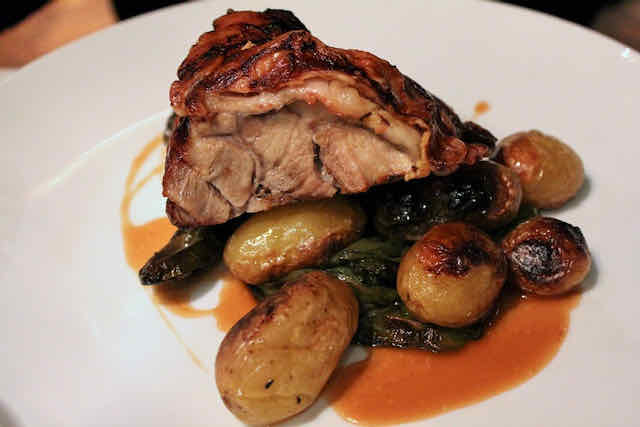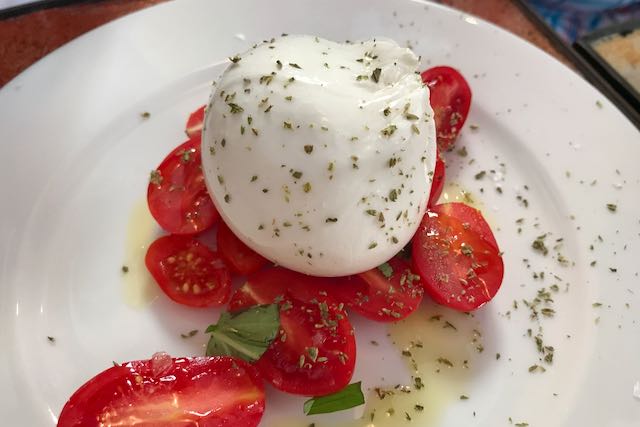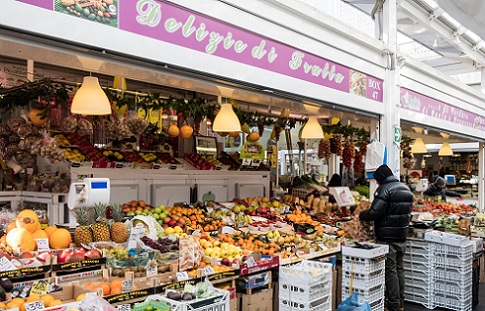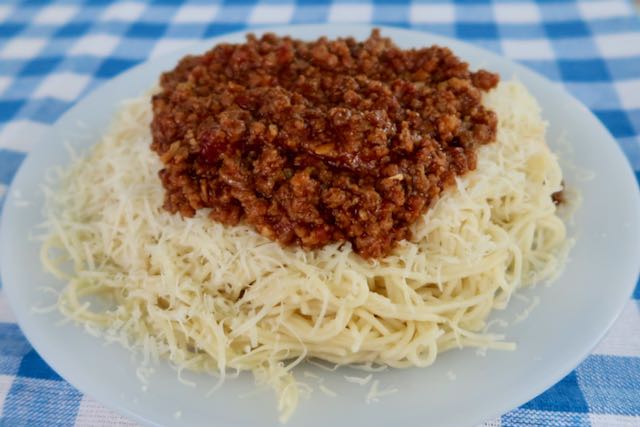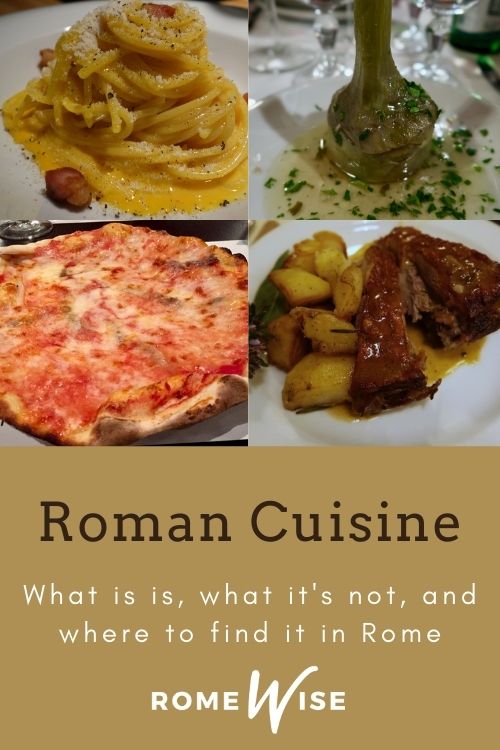- Sign up & get a FREE ebook Subscribe NOW!
- Romewise Home Page
- Where to Eat
- Roman Cuisine
What's So Special About Roman Cuisine? To me, a lot!
What is Roman cuisine all about?
Do you want to know what to order in Rome?
What some typical Roman dishes are?
Where the best restaurants for Roman food are?
Here's What You Need to Know About Roman Cuisine
- What is Rome cuisine and why is it different from other Italian cuisines?
- What foods do you typically find in Rome today?
- What pasta should you order if you want to try Rome cuisine?
- Where in Rome can you try the best examples of Roman foods?
- What are some good wines to order with Roman food?
- What did the Romans eat 2000 years ago and do Romans today still eat that?
- How hard is it to eat in Rome if you are Celiac/Vegetarian/Kosher/Halal/Dieting?
What is Roman Cuisine?
Italy has 20 regions.
The cultures, cuisines, and sometimes, even languages can vastly differ from region to region.
As an example, where food is concerned, you will usually find pasta throughout Italy, but the kinds of pasta and the toppings change quite a lot from region to region, and sometimes even within a region.
There are some pastas that you will typically find in Rome but not as easily in other parts of Italy.
Skate soup?
Roman food today is not what it was 2000 years ago, or even 500 years ago, but there are certainly a lot of roots in older Roman traditions.
Take, for example, a very local Roman dish "soup of skate with broccoli" (in Italian, minestra d'arzilla or brodo d'arzilla).
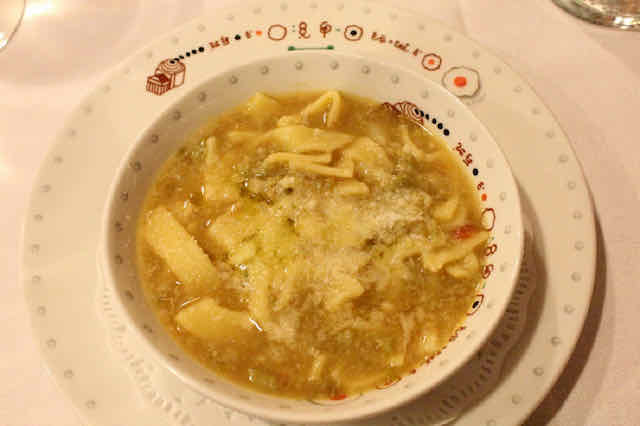 Armando al Pantheon restaurant. Popular with locals and visitors alike for "its own Roman cuisine", it is a place to savor traditional Roman dishes with innovative methods.
Armando al Pantheon restaurant. Popular with locals and visitors alike for "its own Roman cuisine", it is a place to savor traditional Roman dishes with innovative methods.Skate is a fish, like a little stingray without the stinger.
Up until about 500 years ago, those little guys were swimming all around the Tiber river, and people used to catch and eat them.
Today they are gone from the Tiber, so the skate comes from the sea, but the soup is still considered a traditional Roman dish (I love this dish when I can find it - it is simple, delicate and sublime.)
Click here to read more about food in Ancient Rome, and what survives today.
Ready to plan your trip?
Book your train
Planning to travel between cities in Italy and other parts of Europe?
Use Trainline to see all the different options available across the different rail companies.
Find your hotel
Find your perfect place to stay in Rome.
Use Booking.com to choose between hotels, guesthouses, and self-catering apartments in neighborhoods throughout the Eternal City.
Buy your TurboPass
Purchase the convenient Turbopass and visit all of Rome's top attractions including the Colosseum, Pantheon, and Vatican.
With one handy pass, it's all included.
Traditions of Roman cuisine Today
A lot of Roman cuisine today comes from traditions that were based on poverty: people ate what they could get their hands on, the stuff the wealthy considered inedible and tossed away.
Many of the foods Romans today consider “Roman” are in fact based on old Jewish Roman cuisine.
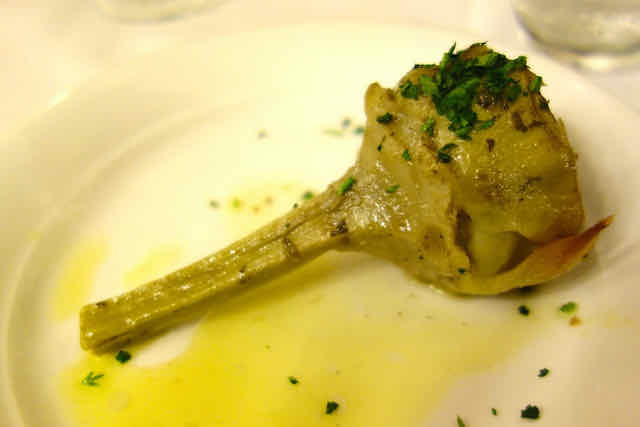 More than a half-century old, Roberto e Loretta restaurant is as old-school as it gets. The Mancinelli family still owns this restaurant that started as a Trattoria in another location in the iconic San Giovanni neighborhood
More than a half-century old, Roberto e Loretta restaurant is as old-school as it gets. The Mancinelli family still owns this restaurant that started as a Trattoria in another location in the iconic San Giovanni neighborhood- Artichokes? They are thistles and were not considered a very edible plant back then.
- Ox-tail stew? Well, it’s the leftovers from a large, meaty animal.
- Zucchini flowers? It's the part of the vegetable you threw away.
Today, you find zucchini flowers throughout Roman cuisine, and it’s considered a delicacy: pizza topped with zucchini flowers, stuffed zucchini flowers and spaghetti and clams with zucchini flowers are some classic examples of typical Roman foods.
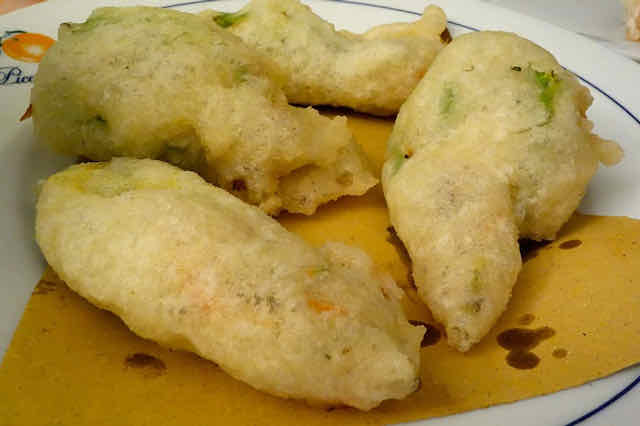 The centrally located restaurant Piccolo Arancio opened many years ago. Carlo and Mara's timeless cooking is famous for still maintaining its traditional Roman style without however neglecting the best national dishes.
The centrally located restaurant Piccolo Arancio opened many years ago. Carlo and Mara's timeless cooking is famous for still maintaining its traditional Roman style without however neglecting the best national dishes.Then there's the "quinto quarto", one of the quintessential aspects of Roman cuisine.
The quinto quarto ("fifth fourth") refers to all the parts of an animal that are not considered "meat": tripe, intestines, brains etc.
This is also called "offal" and for those who love it, they wax poetic over where to get the best of it in Rome (I am not a fan of it but my dad is.
My husband loves tripe, and many of my Roman friends love these dishes.)
What do Romans eat today?
Speaking from my own personal experience (which, after living here nearly 20 years, I'd say is pretty extensive), I describe Roman cuisine this way:
Seasonal and Local – otherwise known as Slow Food
There is a whole movement that promotes eating locally and sustainably, called Slow Food.
Let's start with Italian food in general, which is (or rather used to be) local and seasonal.
This is slowly changing.
There are greenhouses all over Italy, so you can get tomatoes and eggplant (summer vegetables) year-round.
(I don't buy tomatoes in winter, even from hot houses. They just don't taste like much when out of season.)
Things are getting shipped between countries all over Europe, so I am now finding asparagus from Spain in the winter.
Hmm.
And artichokes, once a typical winter/early spring dish, are available year-round now.
Once, horrified to find artichokes in July, I asked the restaurant owner about it and he said, well tourists want them.
Not to lay blame, because I think everyone likes them.
But in July, those artichokes are not from Rome, they are from Bretagne, France.
They are still good.
Just FYI.
So, to speak specifically about Roman Cuisine, here are the types of foods you will find on Roman menus today:
Want to know more about Italian Food Customs?
Roman Cuisine - Appetizers
If you are eating typical Roman cuisine, you will find the following types of appetizers:
Fried appetizers include stuffed zucchini flowers (fiori di zucca), stuffed fried olives (olive ascolane), potato croquettes, supplì ( a rice ball with mozzarella) other fried vegetables and battered and fried salted cod (baccalà).
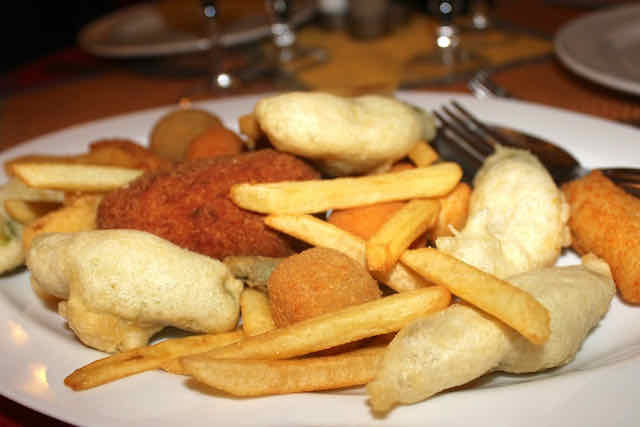 Fried appetizers we have in Rome before having pizza for dinner (I can never resist this and it somehow does not ever ruin my appetite).
Fried appetizers we have in Rome before having pizza for dinner (I can never resist this and it somehow does not ever ruin my appetite).Sometimes you will find an antipasto bar, which usually has a lot of veggies, but also cheeses, seafood, and sometimes meats.
Typically, if you get to help yourself, you are allowed one trip only.
Other times, the wait staff might prepare a plate for you (you can let them know if there is something you want/don't want).
Depending on the restaurant and the antipasto bar, sometimes I can turn this into a meal in itself - great if you're looking for a cheaper option!
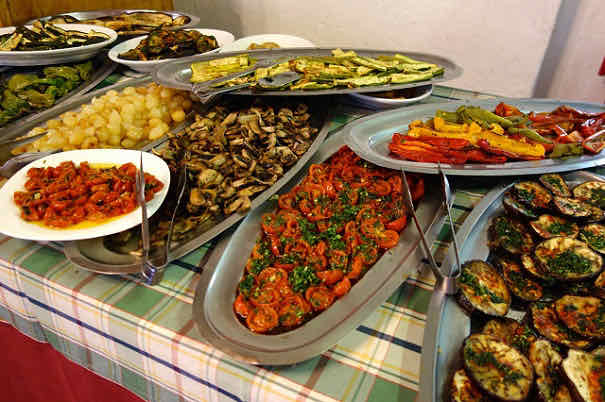 The aromas of tomatoes sauce, chicken cacciatora, and baked lamb are just a few, upon entering the Suburra’s restaurant in the Monti area. The space still has a neighborhood charm to it and feels like a mashup between a diner and delicatessen.
The aromas of tomatoes sauce, chicken cacciatora, and baked lamb are just a few, upon entering the Suburra’s restaurant in the Monti area. The space still has a neighborhood charm to it and feels like a mashup between a diner and delicatessen.Another popular appetizer is bruschetta, often topped with tomatoes and a drizzle of olive oil, or perhaps some garlic or basil, or a slather of a spread such as artichoke, olive or truffles.
Bruschetta is a personal no-no for me, as it fills me up too much.
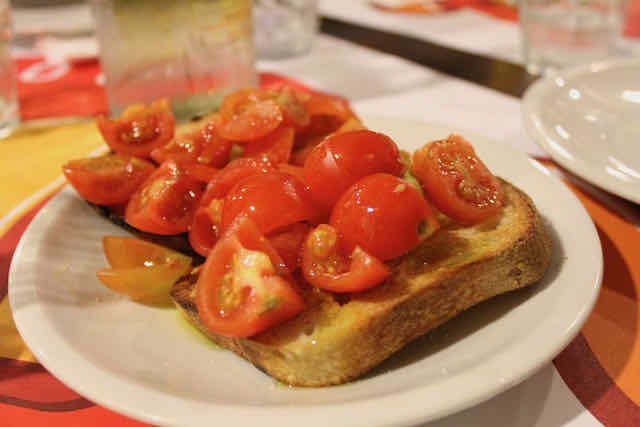 Bruschetta on homemade bread is about as Rome as it gets. This authentic Roman appetizer it’s usually topped with simple yet high-quality ingredients of our territory such as Extra Virgin oil of Oil, seasonal tomatoes, and garlic. This is a must-eat in Rome.
Bruschetta on homemade bread is about as Rome as it gets. This authentic Roman appetizer it’s usually topped with simple yet high-quality ingredients of our territory such as Extra Virgin oil of Oil, seasonal tomatoes, and garlic. This is a must-eat in Rome.If you are in a restaurant that serves seafood, typical appetizers include marinated anchovies, steamed clams and mussels, or a cold seafood salad.
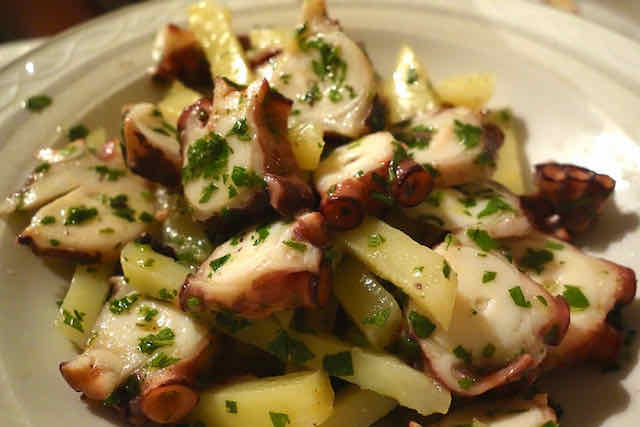 CapoBoi seafood restaurant located in the hush posh neighborhood of Pinciano also includes a menu of fried seafood platters as well as crab, crawfish, and red tuna steaks. There’re shrimps, oysters among the finest, and its famous entrees risottos and pasta with mussels and clams.
CapoBoi seafood restaurant located in the hush posh neighborhood of Pinciano also includes a menu of fried seafood platters as well as crab, crawfish, and red tuna steaks. There’re shrimps, oysters among the finest, and its famous entrees risottos and pasta with mussels and clams.Ready for a Food Tour in Rome?
Learn first hand all about Roman Cuisine, and taste as you go!
Pasta in Rome
You might think pasta is pasta, and that you can get pasta anywhere in Italy.
Yes, you will find some form of pasta just about everywhere in Italy, but the types, shapes, and toppings change from region to region.
Pasta in Rome is typically long, such as spaghetti, fettucine, tagliatelle or tagliolini; or short dried pasta such as farfalle (little bow ties), rigatoni or penne.
(Stuffed pastas like ravioli and tortellini and lasagna are more commonly found in other regions of Italy.)
The most typical Roman pastas are amatriciana, cacio e pepe, gricia and carbonara.
Here are some of my favorite places to eat these dishes:
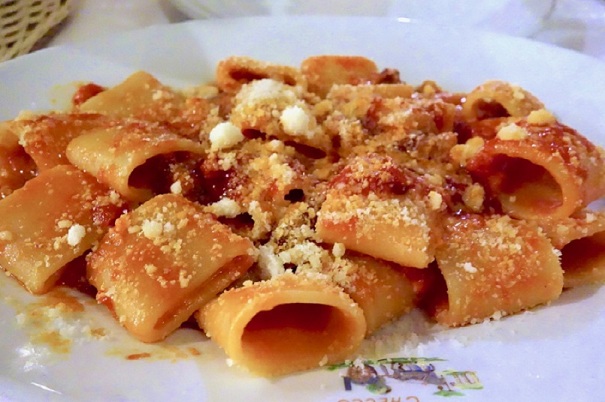 Amatriciana at Checcho er Carattiere
Amatriciana at Checcho er Carattiere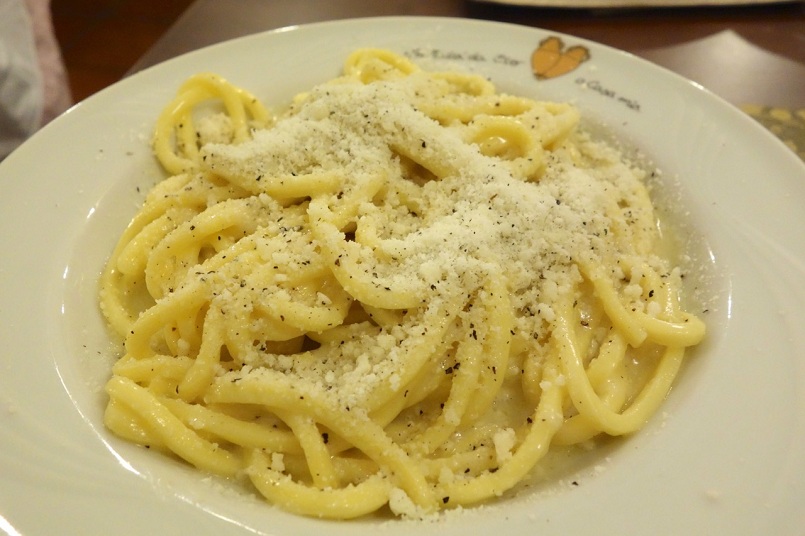 Cacio e pepe at Da Oio a Casa Mia
Cacio e pepe at Da Oio a Casa Mia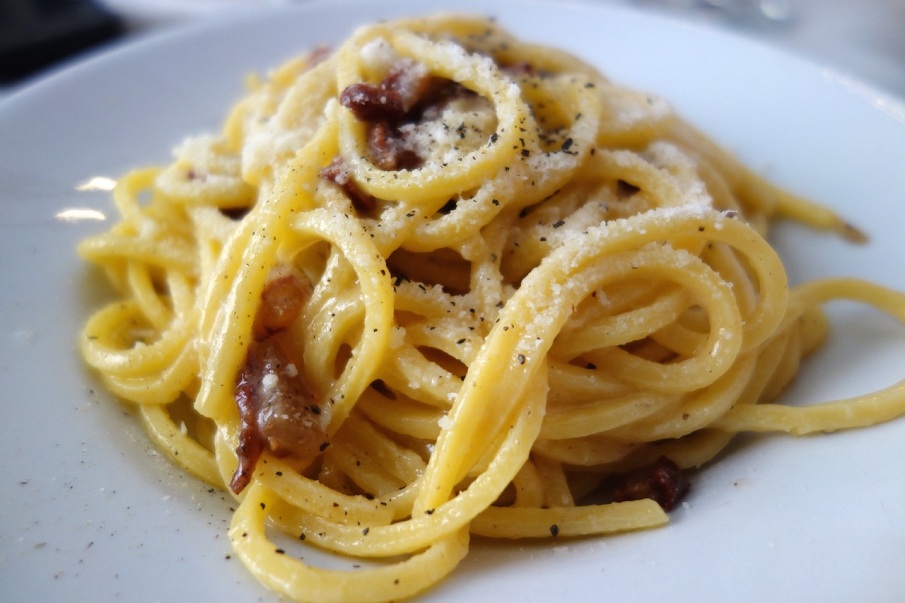 Gricia at Fiaschetteria Marini
Gricia at Fiaschetteria Marini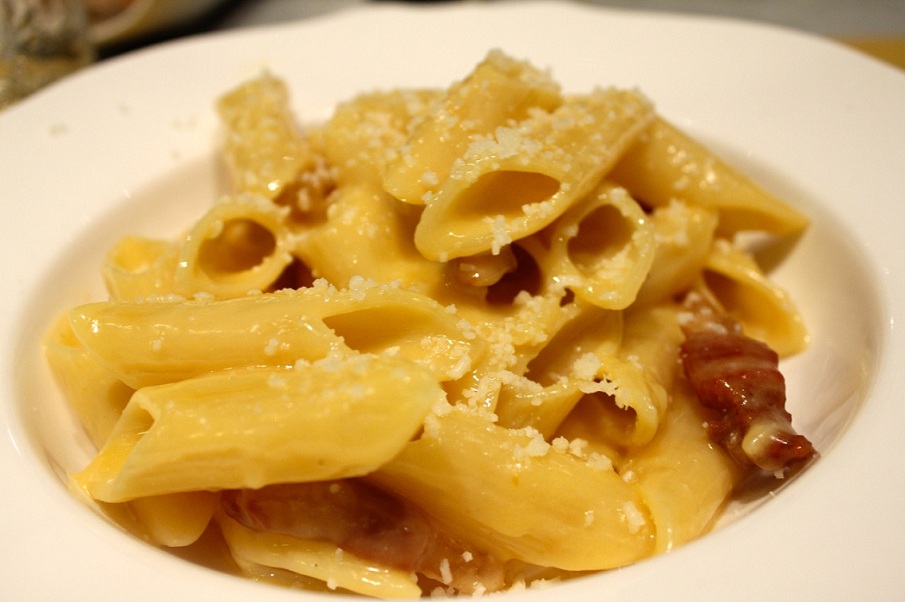 Carbonara at L'Arcangelo
Carbonara at L'ArcangeloYou will also often find fettucine with funghi porcini, spaghetti with tomato and basil sauce, and spinach and ricotta filled ravioli.
Carbonara is relatively new
The origins of pasta in Italy are a little murky but let's say it's been around for centuries, possibly introduced through trading with Middle Eastern countries in the middle ages.
The current "traditional" Roman pastas - cacio e pepe, carbonara, amatriciana and gricia - all go back only a few decades. Maybe 60-70 years.
So while they are firmly planted in the repertoire of Roman cuisine today, they are not from ancient Rome or even from more than 100 years back.
Looking for spaghetti and meatballs?
Fettucine Alfredo?
We are starting to see these more and more in Rome - pretty much in touristy restaurants.
🥂 A Culinary Adventure in Rome 🥂
Indulge in Rome’s flavors! This experience combines a hands-on cooking class, and a walking tour of Rome for an unforgettable culinary adventure.
Other "primi" or first courses in Rome
A primo means a first course (after the antipasto or appetiser). Other than the above-described pasta dishes, classic Roman primi include:
- Soups (minestre), often made with legumes and grains. For example zuppa di farro is a vegetarian soup made with spelt, a thick chewy grain. It's wonderful in fall and winter. Another classic is minestra di ceci e vongole, which is a soup of chick peas and clams (other shellfish can be used as well).
- Risotto dishes are more varied and common in the north of Italy but you will often find risotto alla pescatora (risotto with shellfish) and risotto with radicchio and gorgonzola. They are not considered classic Roman cuisine but they are delicious and fairly easy to find in Rome.
- Gnocchi, or potato dumplings, are not that common on everyday Rome menus, but if you eat at a traditional Roman trattoria, then you will find gnocchi (usually with tomato basil sauce, or sometimes with a butter/sage topping or with gorgonzola cheese sauce), on Thursdays.
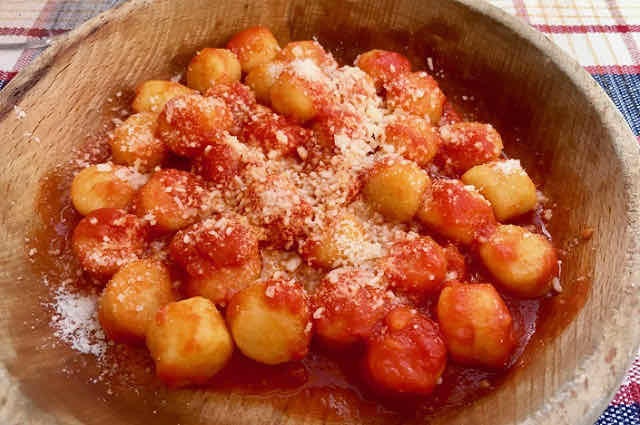 In a city of food snobs, Romans don’t ever eat bad stuff. Since this Roman-born specialty first came in, gnocchi al Pomodoro are a favorite among locals. These potato dumplings are thoroughly topped with a dense tomato sauce and sprinkled with pecorino cheese.
In a city of food snobs, Romans don’t ever eat bad stuff. Since this Roman-born specialty first came in, gnocchi al Pomodoro are a favorite among locals. These potato dumplings are thoroughly topped with a dense tomato sauce and sprinkled with pecorino cheese.Disclosure: If you make a purchase through a link on this page, I may receive a small commission - at no extra cost to you.
Thank you for supporting my site!
Chicken dishes in Rome
Roman cuisine barely includes chicken at all.
If you find chicken on a menu in Rome, it will usually be served as a grilled breast; or chicken parts (on the bone) that are slow cooked in wine.
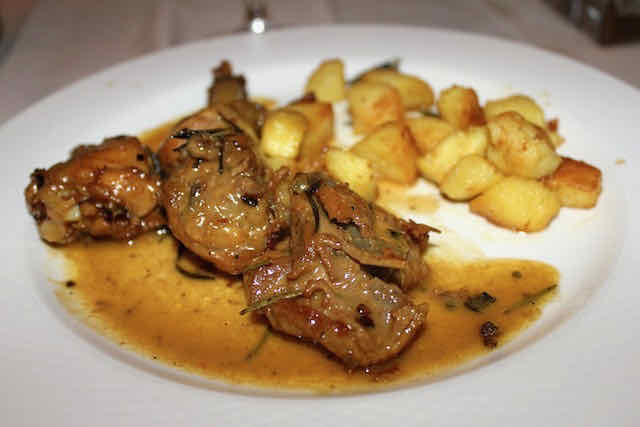 Chicken "cacciatore" at Del Sostegno, which is made by slow-cooking the chicken in white wine, vinegar, garlic and rosemary. Oh and those potatoes cooked along with it. Crazy good.
Chicken "cacciatore" at Del Sostegno, which is made by slow-cooking the chicken in white wine, vinegar, garlic and rosemary. Oh and those potatoes cooked along with it. Crazy good.There is also a traditional Roman dish - chicken with bell peppers, often eaten only in summer (since peppers are a summer vegetable).
That’s about it.
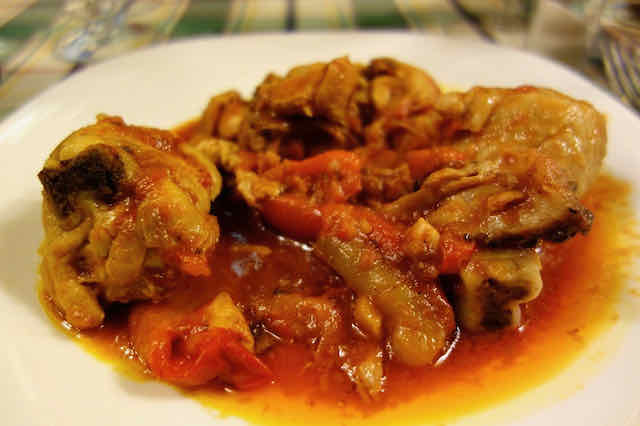 No disrespect to many of our region's dishes but sometimes (read always) it’s worth indulging in a traditional Roman-style chicken with peppers. At Suburra's you'll have according to tradition.
No disrespect to many of our region's dishes but sometimes (read always) it’s worth indulging in a traditional Roman-style chicken with peppers. At Suburra's you'll have according to tradition.Chicken dishes not to look for in Rome include Chicken Parmesan, Chicken Alfredo, Chicken Piccata or any pasta with chicken in it.
These are all part of Italian-American cuisine and you won't (likely) find them here.
Meat dishes in Rome
Meat dishes in Rome include beef, lamb, and pork.
You will also sometimes find some game birds and boar dishes on the menu (these animals live all around Lazio, the region where Rome is).
One classic Rome dish is beef straccetti, which are thin strips of beef, slowly cooked in their own juices, and then served alone on a plate, served with parmesan cheese, arugula (rocket) or artichokes.
If done right, they are very tender and juicy.
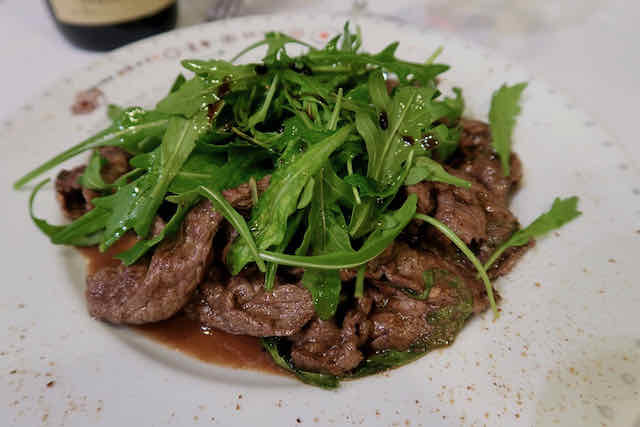 Beef straccetti are as ubiquitous to Rome as scooters on the curbsides. Traditionally made of beef or veal stripes this Roman-style dish is flavored with rocket, cherry tomatoes, parmesan, and balsamic vinegar.
Beef straccetti are as ubiquitous to Rome as scooters on the curbsides. Traditionally made of beef or veal stripes this Roman-style dish is flavored with rocket, cherry tomatoes, parmesan, and balsamic vinegar.You will also typically find beef served as a simple grilled steak, or as a “tagliata”, which means, a steak that gets sliced just as it comes off the grill.
This is another super juicy way to eat steak in Rome.
Another typical Rome meat dish is lamb "scottadito", which means, lamb chops so hot and crispy, they burn your fingers.
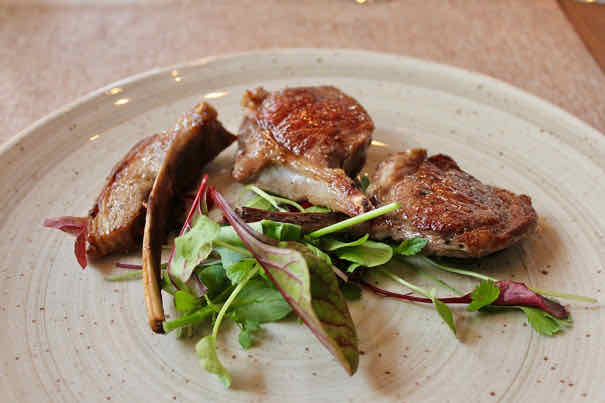 Originally a regional invention, these succulent crispy ribs have become one of the most famous dishes in Rome. The dish is typically prepared with lamb ribs, usually leaner baby back ribs.
Originally a regional invention, these succulent crispy ribs have become one of the most famous dishes in Rome. The dish is typically prepared with lamb ribs, usually leaner baby back ribs.Spezzatino, or cut up pieces of meat (beef, pork or lamb), sometimes on the bone, and cooked until it's falling apart, is another dish you will find on Roman menus. It's homey and simple, much like a hearty stew.
The perfect 3-day itinerary in Rome
Trying to figure out how to organize your visit to Rome? I've got the perfect 3-day itinerary for first-time visitors (or those who have not been here in a while.) It works for a 2.5 day visit as well.
In my 3-day itinerary, you'll see all the major must-see Rome attractions like the Vatican, Colosseum, Trevi Fountain, Pantheon, Piazza Navona, Spanish Steps, and much more.
And if you have more time, or want suggestions for extra/other things to do, you'll find that there too.
Visit my page with the best 3-day itinerary in Rome for first-timers.
Pork in Roman cuisine
There is a lot of pork in Roman cuisine.
You will often find it in pasta sauces such as amatriciana, gricia and carbonara.
Two other common pork dishes in Rome are porchetta, a baby pig stuffed with herbs and slowly cooked:
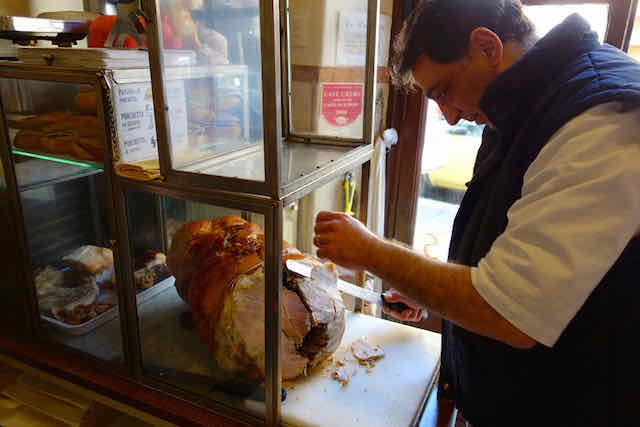 Porchetta. It is one of the pork-based dishes which leans on the region-style rather than Roman. The meat has a distinct taste and the aromas of its seasoning are spices and herbs. Smashed into a piece of homemade bread, it's a must to have while in Rome
Porchetta. It is one of the pork-based dishes which leans on the region-style rather than Roman. The meat has a distinct taste and the aromas of its seasoning are spices and herbs. Smashed into a piece of homemade bread, it's a must to have while in Rome. . . and maialino al forno which is very tender, slowly baked baby pig.
This dish is often served with roasted rosemary-herbed potatoes.
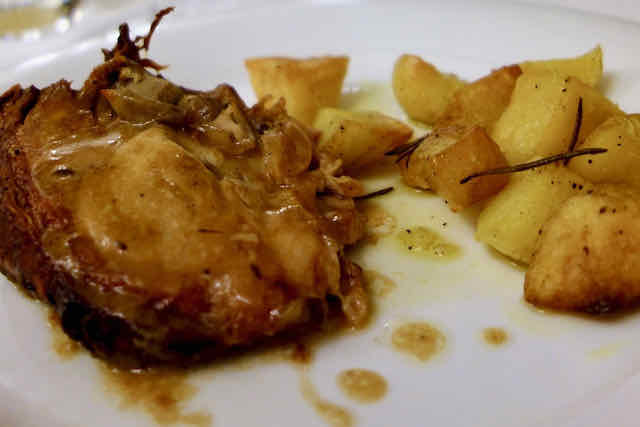 Maialino al forno at Roberto e Loretta, one place you will find it made particularly well.
Maialino al forno at Roberto e Loretta, one place you will find it made particularly well.Romans also use pork in other foods, like stews or bean dishes.
The idea is that it is the secret ingredient that adds saltiness.
The "quinto quarto", otherwise known as offal
This section is not for the squeamish.
That includes me.
I don't eat offal, but I am often with people who do.
Also, I take cooking classes and have learned how to make some of these traditional dishes from Roman cuisine, so I know what they are about.
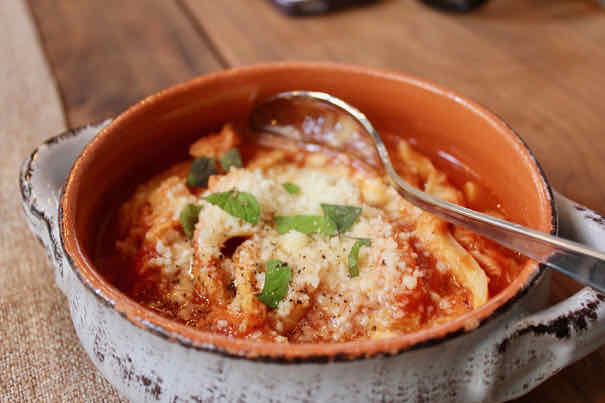 Tripe with tomato sauce and pecorino cheese. One of the oldest Roman soul food along with the beef tongue, brain fried, pork cheeks, and cow kidney.
Tripe with tomato sauce and pecorino cheese. One of the oldest Roman soul food along with the beef tongue, brain fried, pork cheeks, and cow kidney.And, when my dad comes to Rome, he makes it a point to try these dishes everywhere he can.
So I've seen a lot of Roman offal in action!
The words quinto quarto literally mean the fifth fourth.
Not mathematically possible you say?
Well in Roman, this refers to the "other" parts of the animal not normally considered meat.
If you butcher an animal and cut it into four parts, there are still lots of things you might throw away (remember, Roman cuisine is based historically on poverty, and people eating things the wealthy discarded).
So this includes tripe, intestines, kidneys, heart, lungs and brains.
Some typical Roman offal dishes include:
- Trippa alla romana - Trippa or tripe, is stomach lining. Stew it a long time in some tomato sauce, sometimes with onions, and voila, trippa alla romana.
- Rigatoni alla pajata - pajata is the intestine of a baby lamb or veal. It is still full of milk, so when you mix it with tomato sauce, the sauce becomes creamy. Add this sauce to rigatoni and you have a very filling meal.
- Coratella - this classic Roman dish is made with heart, lungs and livers, and usually onions. When in season, add artichokes and you have a very tasty, hearty meal.
Jump start your trip to Rome with a free ebook 😀
Sign-up to our free newsletter and receive our Quick Start Guide to Rome ebook which share's everything you need to know to plan the perfect trip to the Eternal City 🙌
Anchovies in Roman cuisine
The other “natural salt” ingredient is anchovies (you won’t find both anchovies and pork together in the same dish; it's one or the other, depending on the dish).
 For the most part, bruschettas are topped with the same products: homemade bread, dependable oil of olives, and fresh tomatoes. At Flaviovelavevodetto managed to raise it a notch up. Try it with burrata cheese and anchovies
For the most part, bruschettas are topped with the same products: homemade bread, dependable oil of olives, and fresh tomatoes. At Flaviovelavevodetto managed to raise it a notch up. Try it with burrata cheese and anchoviesAs much as zucchini flowers are a delicacy in Roman cuisine, adding those anchovies definitely gives the dish a kick of needed salt.
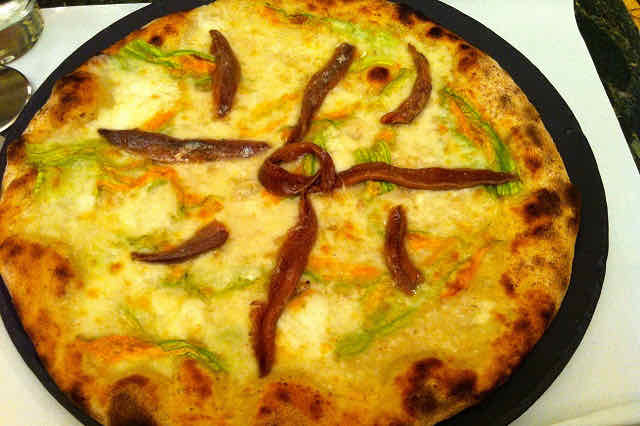 Ciampini's restaurant and cafè have endured for more than a half-century in the center of town thanks to generous and delicious pizzas topped with its iconic ingredients.
Ciampini's restaurant and cafè have endured for more than a half-century in the center of town thanks to generous and delicious pizzas topped with its iconic ingredients.I know not everyone is an anchovy fan.
But if you are not completely anti-fish, and the only kind of anchovies you've ever tried are the ones that come in oil in a tin, I urge you to try fresh anchovies in Italy.
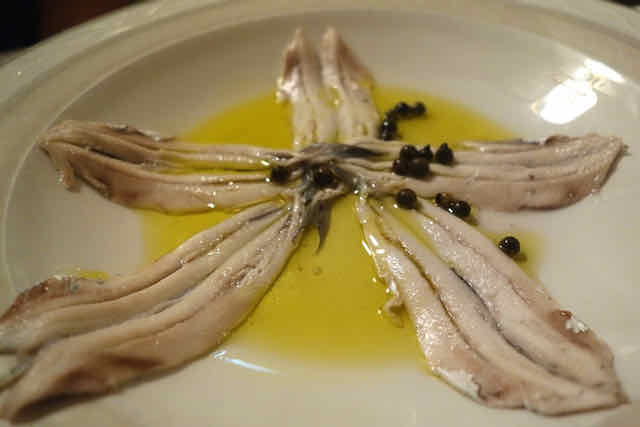 CapoBoi restaurant amps up soul Roman classics with nourishing shrimp and raw shellfish delicacies, along with marinated anchovies Cantabrian in the oil of Olives.
CapoBoi restaurant amps up soul Roman classics with nourishing shrimp and raw shellfish delicacies, along with marinated anchovies Cantabrian in the oil of Olives.Anchovies are native to the Mediterranean, and when you eat them fresh from the sea, slightly marinated, they are a whole different thing from the kind in the tin.
Spicy Roman food
Roman food is not usually spicy (hot), although there are a few exceptions (refried veggies or with steamed clams and mussels).
You can also ask for peperoncino, (red hot pepper flakes), or oil with peperoncino.
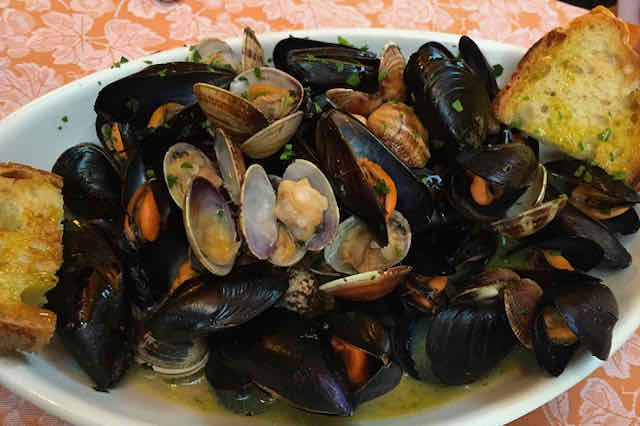 Another specialty of fresh seafood, a habit among Romans is simple but yummy. Do not miss the famous dish of mussels and clams sauteed.
Another specialty of fresh seafood, a habit among Romans is simple but yummy. Do not miss the famous dish of mussels and clams sauteed.Garlic in Roman food
There is very little garlic used in Roman cuisine, with a few exceptions - refried veggies, clams/mussels sauté, and puntarelle - a Roman seasonal (winter and early spring) salad made with fresh chicory, anchovies and garlic.
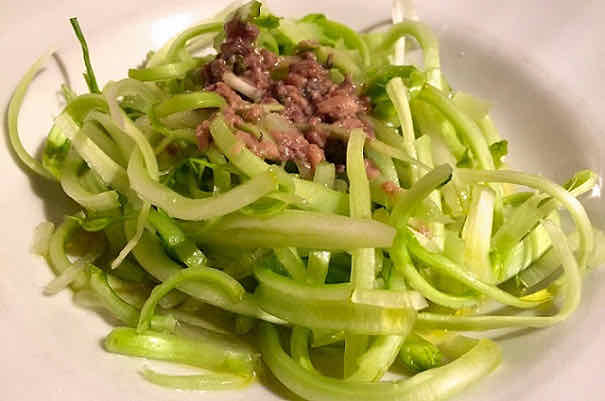 The best example of Rome's iconic veggie dish. Puntarelle alla Romana . At Tre Archi restaurant, you may try this specialty made of fresh chicory tips anchovies, and garlic.
The best example of Rome's iconic veggie dish. Puntarelle alla Romana . At Tre Archi restaurant, you may try this specialty made of fresh chicory tips anchovies, and garlic.Seafood in Rome
You will often find fish and seafood in Rome, although Rome is not really famous for its seafood the way Sicily or Puglia are.
Some typical seafood dishes you will find in Rome include steamed mussels and clams (with garlic and hot pepper flakes); marinated fresh anchovies; spaghetti with clams; spaghetti with shellfish; fried calamari and shrimp.
(Read the above page for more about seafood dishes you will find in Rome.)
When you get fish as a second course, it usually comes baked or grilled, served whole, although they will gladly clean it for you.
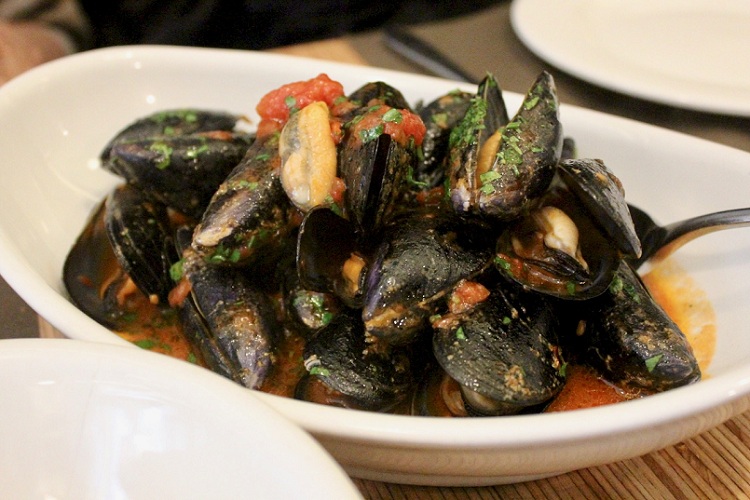
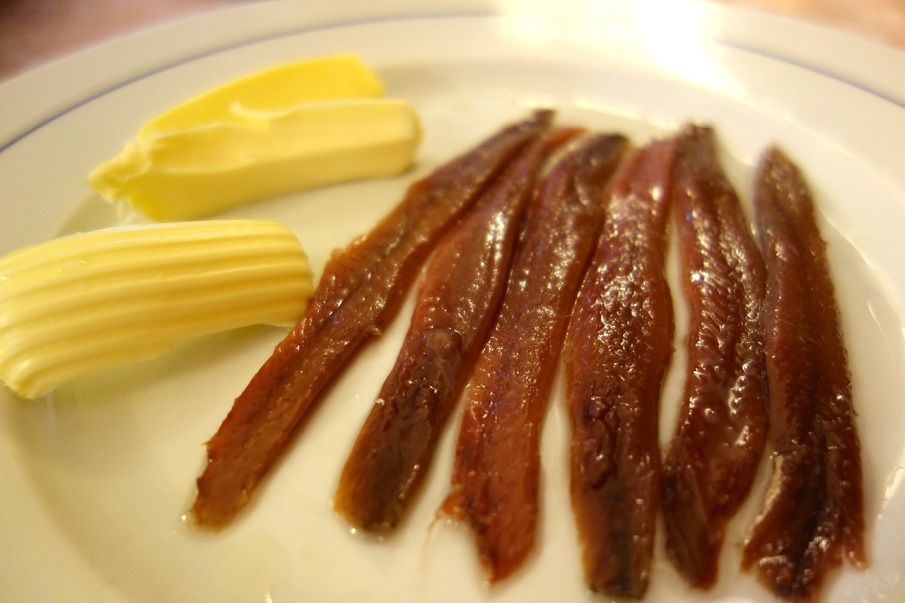
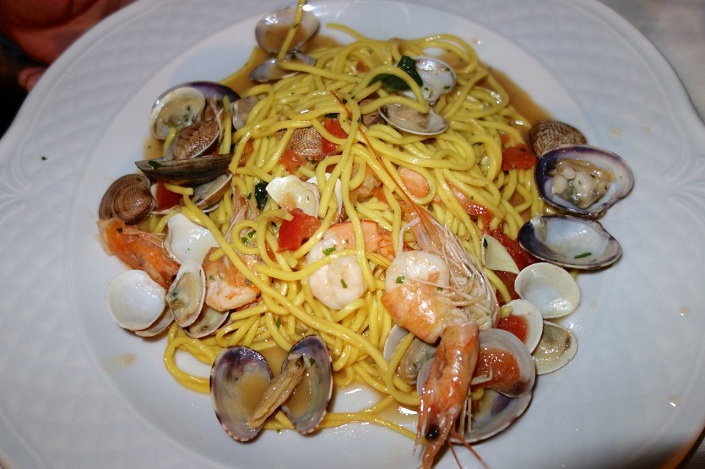
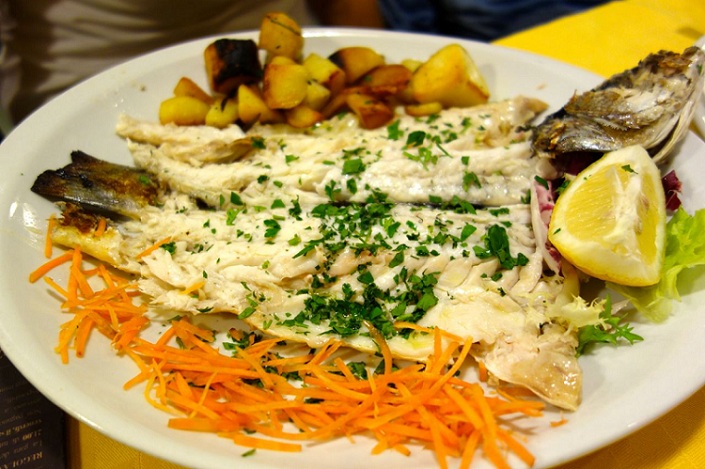
The typical type of fish you find on menus in Rome are cernia (grouper), orata (sea bream), spigola (sea bass), and rombo (turbot.)
You may find swordfish or tuna steaks as well.
Desserts at Rome restaurants
 Typical desserts are displayed at Pancrazio's. A hearty Roman eatery helmed by the longtime Macchionis family, where you can indulge in a carb-heavy meal of pasta, local meats, and a pretty extensive wine list.
Typical desserts are displayed at Pancrazio's. A hearty Roman eatery helmed by the longtime Macchionis family, where you can indulge in a carb-heavy meal of pasta, local meats, and a pretty extensive wine list.If you eat at a classic Roman restaurant, and have room for dessert, you will almost always find exactly the same things served at them all:
- tiramisu (always homemade, they say)
- crème caramel (like Spanish flan, a kind of cooked custard)
- crema catalana (like Crème brûlée, or creamy custard that has been carmelized on top with a flame)
- panna cotta (cooked cream, topped with syrup, chocolate, or berries)
- torta della nonna ("grandma's pie" - a custard pie in a pie shell, topped with pinenuts);
- crostata (fruit jam tart).
There may be a few other goodies thrown in there if they want to be creative but you can almost always count on the first 6.
Some Roman restaurants also give a complimentary plate of biscotti at the end.
Where to find the best Roman Cuisine in Rome?
If you are wondering where to go in Rome to try all these dishes, well, you are not alone.
There are whole food blogs and books just about this subject.
If you have gone through this page from the top, you'll notice I have already given examples of some of my favorite Roman trattorias where you can try great typical Roman cuisine.
You'll find more restaurant on pages dedicated to Rome restaurants throughout this site.
But since you're on this page, I'll give you a short list here (not in any particular order):
trattorias in Rome serving traditional Roman CUisine
- Roberto e Loretta
- Armando Al Pantheon
- Grappolo d'Oro
- Romolo e Remo
- Checco Er Carettiere
- Da Cesare al Casaletto
- Matricianella
- Dal Cavalier Gino
- Da Felice
Of course, there are many more, but this will get you started.
What are some good wines to have with Roman Cuisine?
Visit this page for a beginner's guide to Italian wine.
For the purposes of giving you a few helpful hints, right on this page, I suggest that if you want to know which wines to drink when dining out in Rome, follow these tips:
- Try the house wine. In Italy, house wines can be quite good.
- Try some Lazio wines. There many wine regions in Italy. Rome is in the "Lazio" region. When eating Roman cuisine, a good option is to pair it with Lazio wine.
- Ask your server what they suggest. Even a server who is not a trained sommelier, but who is well-versed in Roman cuisine, and who works in this area daily, will be able to suggest a wine with what you order. And if not, they may call over someone else working in the restaurant who can.
- In general, good wines tend to cost less in Rome restaurants than they do in other parts of the world. A fairly good bottle of white can run anywhere from 12€ and up, and a good red can be anywhere from 16€ and up.
Even in Lazio, we have many varieties of wine, and from different areas around Lazio.
As a small guide, by no means by a sommelier (I am NOT), know that:
- Frascati is best known for their white wines. I find them to be a bit to acidic, but the Reserve whites are much better (now we are getting down to opinion.)
- A winery whose wines you will find often on Roman menus is Casale del Gigilio. Their less expensive wines (red and white) are consistently good, and their expensive (25€ + for a bottle) wines are fantastic. My friends and I like their Satrico for white, and Syrah for red.
- We also love the Tellus wines by Falesco.
- A typical red varietal from Lazio is called Cesanese del Piglio, and you'll find many varieties of these from different wineries and areas around Rome. I like this wine a lot, and my husband does not. I find it nice and full-bodied, with generally low acidity, and it tends to go well with amatriciana.
- Some will say that you should have a white with the "white pastas" - cacio e pepe, gricia, and carbonara; and a red wine with the "red pastas" - amatriciana or another pasta with tomato sauce. Up to you of course.
What Romans Ate in Ancient Rome
To keep things simple, I'll just give you a broad overview of some of the foods the Romans ate 2000 years ago.
Of course their cuisine evolved over the centuries, influenced by various cultures (Greek and others), and by food they began importing from across the empire and eventually from the far east.
Ancient Romans ate bread, made with wheat and other grains.
They ate fish, game, birds, legumes, olives, fruits and vegetables.
One thing they ate that intrigues me is called garum, which was a sort of food seasoning made by piling anchovies in a barrel, covering them in salt, and letting them rot.
We use a version of this today, called colatura di alici, in some pasta recipes, in particular from southern Italy (similar to but much stronger than "fish sauce" used in some Asian cooking).
But what the Romans ate . . . I cannot even imagine the smell and how they would have thought, yum, let's use this in our cooking!
Ancient Romans ate artichokes, olives and olive oil, nuts, fruit, legumes, wheat and other grains, and plenty of fish, in particular anchovies.
Wealthier Romans had access to cheese, honey and eggs.
These are all found in Roman cuisine today, even if in slightly different form or use than in Ancient Rome.
When we think of "Roman Cuisine" today, one of the things that comes to mind is pasta.
This did not appear in Italian cooking until sometime in the middle ages.
And the dishes we associate with Roman Cuisine such as carbonara and amatriciana are only from at most about 100 years ago.
Pizza was invented in Naples sometime during the Renaissance.
Today pizza is a favorite in Rome, but it was not eaten in Ancient Rome.
Eating in Rome with restrictions
Are you wondering how hard it will be to visit Rome when you are
- Celiac or otherwise not eating gluten?
- Kosher or Halal?
- Vegetarian/Vegan?
You might be surprised to know that it's quite easy to eat, and eat very well, in Rome even if you have some restrictions.
Much of Roman cuisine is based on vegetables, legumes and fruits, so it can be easy to avoid meats, fish and cheeses.
As for eating gluten-free, stay tuned for an upcoming page about this but in the meantime, I can tell you that Italy is one of the most celiac-aware countries, and you will not have any trouble finding restaurants that either serve gluten-free food, or will otherwise be glad to accommodate your request.
Visit the official website for the Italian Celiac Association to search for Italian businesses that specialize in catering to celiacs.
Romewise's Top Travel Resources
Ready to book your trip to Rome? Take a look at these helpful links to companies we use and trust:
- Keep your travel spending simple with the Wise card, which removes all the worry about exchange rates and high transaction fees all over the world
- Search for and book your perfect accommodation
- Our complete guide to what to pack for Rome
- The number one travel accessory, a multi-point travel adapter and voltage converter
- Browse a huge range of tours in Rome and beyond
- Experience unique tours and special access to Rome's most popular sights
- Protect yourself with comprehensive travel insurance
Within this post there are some affiliate links for products and services. For more details about our affiliate policy click here.
Get your 100% free Rome trip planner now!
Simply sign-up today for our free newsletter and get the Romewise Quick Start guide to Rome:
We are committed to respecting your data. Click for our Privacy Policy.
Comments? Questions? Suggestions?
Please come over to the private Romewise Facebook group and join in the conversation.
You will often find me there, happy to answer your questions / comments!
You will also meet other Rome lovers and experts, too.
What are you waiting for?
- Romewise Home Page
- Where to Eat
- Roman Cuisine

